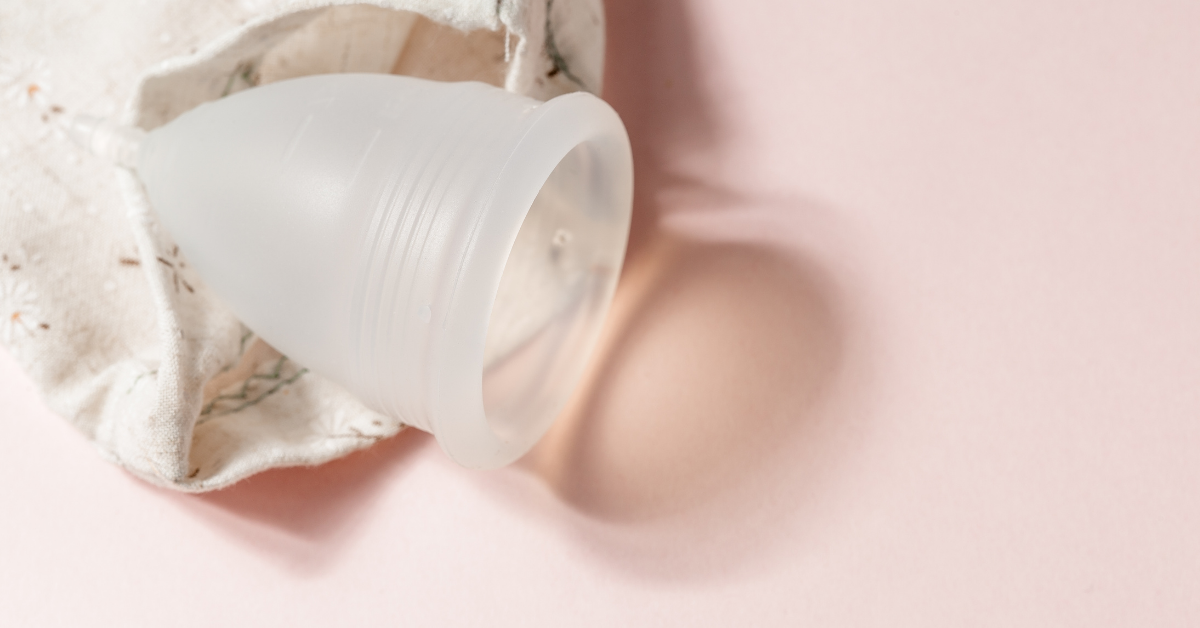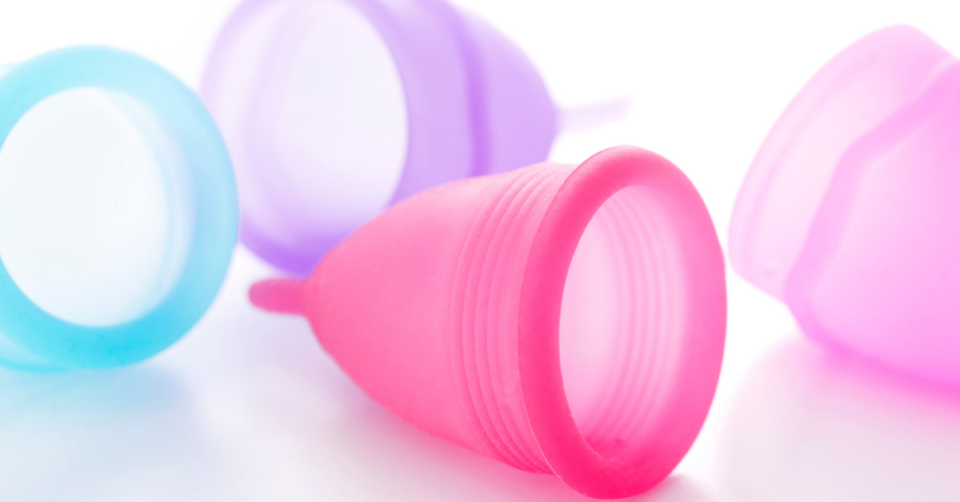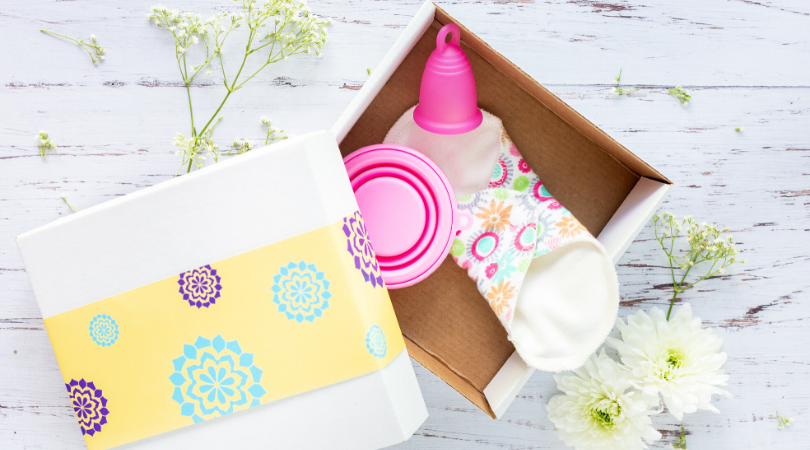
All You Need To Know About Using A Menstrual Cup

Plastic-free periods have been taking the spotlight in the last few years and having several choices now means that every period can be more comfortable, more affordable in the long run and better for your health as well as for the environment. The three options that are currently available to use are cloth sanitary pads (CSP), period pants and the menstrual cup. All three can be used, washed and reused. You can choose just one, you may want to choose two options or you can mix it up and go for all three. For example, on heavier days you may feel better wearing a period pant as you get that all round protection, at night you may like CSP and for swimming the menstrual cup may be your go to plastic-free period product. The joy of having all of these is that you can choose what will work for you.
Now, I have previously talked a lot about Cloth Sanitary Pads (CSP) and period pants both on my blog and social media but I haven’t so much with the menstrual cup which is what prompted this article. It is definitely the menstrual product that brings up the most questions and worries so let me try and answer what I can and cover all you need to know about using one.
Why Choose To Reuse?
By choosing a reusable period product you will be helping to prevent further waste from entering our landfills, waterways and oceans or being incinerated. We are all very aware of the waste issues we are facing across the globe and that plastic waste is one of our biggest problems as this will never go away. Disposable period products are made from plastic which means that they come under that umbrella of being plastic waste.
“In 2018 alone, people in the U.S. bought 5.8 billion tampons, and over the course of a lifetime, a single menstruator will use somewhere between 5 and 15 thousand pads and tampons, the vast majority of which will wind up in landfills as plastic waste”
National Geographic
Each time you choose to reuse, you will be making a difference. Even if you can’t choose a reusable period product for the whole of your flow or if you can’t manage it every month, just one day using a menstrual cup, CSP or period pants will help our environment.
On top of this, you will also be helping your vaginal health as these period products are chemical and toxic free, they are plastic-free and will help to maintain your body’s natural pH balance.
You May Also Like:
- 3 Ways To Have A Plastic Free Period
- Making The Switch To Cloth Sanitary Pads
- WUKA Period Pants Review
- Review: WUKA Period Swim Bikini Brief
- The Clever Cactus CSP and Liners Review
What Is A Menstrual Cup?
A menstrual cup is a silicone cup-shaped item that is used vaginally during your period. The difference between a cup and a tampon is that the cup sits lower than the tampon, it can be worn for longer and it catches your period blood rather than absorbing it. You can reuse your cup for around 10 years meaning you will never be caught without and you will save money in the long run.
Sizing
Typically, menstrual cups come in 2 sizes: 1 for under 30, no children and another for over 30’s who have had children (vaginally). These sizes are just a guide and all brands will vary slightly as do our bodies so I would highly recommend reading reviews, comparing what is available and speaking to friends and family who have one. I purchased a menstrual cup in the recommended size and it was too big and uncomfortable for me. I went for the under 30 option next and it was perfect so don’t be put off if your first choice isn’t quite right.
The other really important step you can take is to take some time to get to know your body. From having smears and babies I know I have a posterior cervix and so I now know how to smoothly insert a cup without any issue. The Period Lady has a great article on measuring your cervix size here which should help you to decide which cup size should work for you.

Sterilising
Before using a menstrual cup and after your period has finished, you should sterilise it in boiling water for around 5 minutes. You should also sterilise it for a few minutes after each use (as in a full day) during your period either in boiling water or using sterilising tabs or fluid.
Inserting
Learning to insert your menstrual cup will take a little time and practice so ensure that you set aside some quiet time to work this out for your body. The key is to stay relaxed, find a comfortable spot and not to rush it. Some women like to lay down, some squat, some sit on the toilet and others stand up, just find what works for you. You should always wash your hands well before each use. One top tip that I have come across is that you may find insertion a little easier if you wet the outside of the cup with a little bit of water or use a water-based lubricant.
There are several ways in which you can fold your cup to get a comfortable and easy insertion and which you go for is all down to personal preference.
C Fold
Take your cup, fold it in half so that the lips touch together, then slowly bend the cup in half again lengthwise. You will see that the point of insertion looks like a C.
Punch Down Fold
Holding your menstrual cup use your thumb to push the lip of the cup down towards the base. Then remove your thumb as you squeeze the edges together.
7 Fold
Fold your menstrual cup in half so that the lips touch. Now pull down the right side, so as to form the shape of a ‘7’ with the lips of the cup.
Origami Fold
Holding your menstrual cup upright, push the front lip halfway down inside the cup (not quite as far as in the Punchdown fold). Now take the right corner of the cup and bring it down to the base of the left side.

Once you have your desired shape, insert the folded menstrual cup into your vagina. Once the entire cup is inside and in the right place for your body, remove your fingers and let it open up.
If the menstrual cup has been inserted correctly, you might hear a “pop” or a suction sound which means that the cup has unfolded and created the necessary suction seal. As mentioned before, in comparison with a tampon, the menstrual cup should sit lower in the vaginal canal and with the stem completely inside of you. If the stem is too long, it can be simply cut to the right size for your body.
Wearing The Cup
A menstrual cup can be worn for up to 12 hours before it needs emptying. This may sound like a long time but in actual fact, most people only lose around 5-12 teaspoons of blood per period and as a cup can hold 3 times what a tampon can, you will feel comfortable and protected for longer. You can wear it for a normal days’ work, for sport, swimming and at night.
Removal
To remove your menstrual cup, first wash your hands well. Next, you will want to pinch the sides of the cup very gently with your fingers. This pinch will release the cup’s suction and will allow you to remove it without it hurting or causing your muscles to tense up. Once you can feel that it has released, gently pull on the stem until the cup comes out.
Emptying and Washing
You can now tip the contents of your menstrual cup into the toilet and then if you need to reinsert it you can either wipe it clean with toilet roll or rinse it under the warm tap. If you are in a public toilet and prefer to rinse your cup, take a reusable bottle of water in with you to use for cleaning. If you won’t be using it again that day, you can now sterilise it and store it away.
Air Holes
All menstrual cups will have air holes around the rim. These help with the suction function and if they become blocked it will affect it’s performance so you must check that these are clear prior to each use. You can clear these with water, with an old toothbrush, with a nail scrubber or a pin.
Common Questions Answered
Will it leak?
As long as your cup has sealed on your vaginal walls, you will not experience any leaks.
Can a menstrual cup cause a prolapse?
I have heard this come up a few times and it seems that there have been rare cases of this occuring which have now caused worry to people. If you make sure that you fully release the cup at each removal you will not be at risk of a prolapse. It seems that misinformation may have lead to some not releasing that seal and pulling their cups out too hard. There has been call in the UK just last year for more brands to give clearer safety advice but as far as I have seen all brands have appropriate info either on their boxes, websites, in articles or on Youtube so do take full advantage of these.
Can I use it with the coil?
Again, just as above, you are fine to use it if you have the coil but you must ensure that you remove the cup correctly. The NHS Devon Sexual Health website has issued this advice via MoonCup:
Please follow the recommendations below when using a menstrual cup if you have a coil:
“The manufacturer of the Moon Cup® recommends waiting for 6 weeks following the insertion of IUC before using the menstrual cup. They also state that the Moon Cup should be placed low in the vagina with an adequate seal, which should be broken before the cup is removed. The manufacturer also recommends checking for IUC threads after each menses. If the threads cannot be located, or if a woman thinks her Cu-IUD has moved or if a woman experiences pain, the manufacturer recommends using additional contraception and consulting with an appropriate health care professional“
Is it hygienic?
Yes, it is perfectly hygienic as long as you follow the brand’s care instructions. Dirty hands and a dirty cup can lead to vaginal issues such as infections so always make sure you have clean hands, that you wash your cup well and sterilise as advised.
Will it cope with clots?
Yes, the menstrual cup will catch the clots as they work their way down. If you are prone to clots you may want to empty your cup more often but as you get used to how heavy they are each month, you will learn to gauge it. The cups are also a good way of checking any changes in them too.
Can I wear a cup postpartum?
No, stick with your extra large pads and allow everything to settle down and heal.
Can a cup get lost or get stuck?
A cup cannot get lost, it will sit firmly against your vaginal walls and there isn’t anywhere for it to go. In terms of getting stuck, if you seize up then your muscles will tighten around the cup which will make it feel as though it is stuck. It isn’t, you just need to relax, breathe, ensure that the cup suction has been released by pinching it and trying again.
Can a teen wear a cup?
Yes.
Can I wear a cup if I have Endometriosis?
This will come down to how it feels for you. If you want to give it a try to see if it is comfortable and if it will reduce cramping then there is no reason not to. As an endo sufferer, I expect you will know your body very well and so you will be able to gauge what your vagina will put up with during your menstruation. I know tampons can be irritating to those with endometriosis but they are rough, drying and contain chemicals like bleach whereas a cup is softer and will not upset your balance.
Can I use a cup if I have Vaginismus?
The answer to this will be similar to above. It is perfectly possible to as it is to have sex or a smear but you will need to feel completely comfortable and find what cup and what technique works for you. Asking brands if they recommend a particular style or size may be your best first port of call as well as reading reviews and articles on this topic. As you can use a waterbased lubricant for insertion this will help and the cup should feel far better than a tampon.
Can I use a cup if I have a tilted cervix?
In this case it may take time to find the correct shape and size as well as the best insertion method but yes, people with tilted cervixes can use a cup. As above, it is all down to personal preference and knowing your body. It may be worth reaching out to companies to find out what cup they recommend from their line. You can find out more on this from The Period Lady here.
How do you remove stains?
Over time you may notice that your cup stains which is perfectly natural. If you want to remove these you can simply scrub it using bicarbonate of soda until the stains lift away.
How many cups do I need?
1 should be enough.
Pros of choosing a menstrual cup
- eco-friendly
- no waste
- safer than a tampon- no chemicals, no toxic shock syndrome
- holds more blood than a pad or tampon
- saves you money in the long run
- never run out
- will not upset your vagina’s pH balance
- some people report having fewer cramps
- no odour
- reliable
- affordable – the cheapest cup is around £5, average is £10-£20.
Cons of choosing a menstrual cup
- can be a little messy
- can be fiddly at first
- you need to take the time to care for it
Switching to a menstrual cup can take some time to get used to the insertion, feel and routine but many, many people rave about this as a reusable period product so it may be worth you giving it a whirl. Of course, if it’s not for you, it’s not for you, but with other eco-friendly options, I’m sure you will find something that is the perfect fit for your period.

Pin for later:





